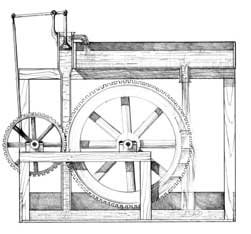
Throughout history it seems as though people have sought to devise contrivances which so closely mimic nature that they take on her indestructibility. A machine which does something with no maintenance, forever. A thing which can be relied upon and ignored. A quick look around the room provides numerous adequate substitutes in the form of consumer electronics and architectural details.
Who made these things? Machines, of course; they were just spit out of some factory somewhere and the first person to touch them was the mail carrier. Hero of Alexandria was one of the first to develop perpetual motion mechanisms. During the Middle Ages scholars and alchemists repeated the designs of the ancients. After the industrial revolution the same designs were again presented. At each stage these designs were retrofitted with the latest technology of the time; donkeys gave way to waterwheels, which became steam engines, nuclear reactors, etc.
One of the greatest artists of the nineteenth century was a man named Keeley, who gave numerous demonstrations of his perpetual motion machine. Upon Keely's demise, the dismantling of his shop building revealed an elaborate mechanism cleverly hidden in the walls and upper floors which operated his machine invisibly. What had appeared to be a perpetual motion machine was in fact being driven by a common motor. The extraordinary ingenuity of the hidden mechanism was in itself considered a feat of some renown.
The spirit of this profound compromise - the giving up on an elusive idea, and the extraordinary measures taken to salvage something of the idea for public consumption is a theme which can be traced not only through art, but through consumer goods, politics, this exhibition, etc. The models of perpetual motion machines present an idealized image of the everyday world; they make the same promises as advertising, such as unlimited power, but unlike advertising, they don't deliver.